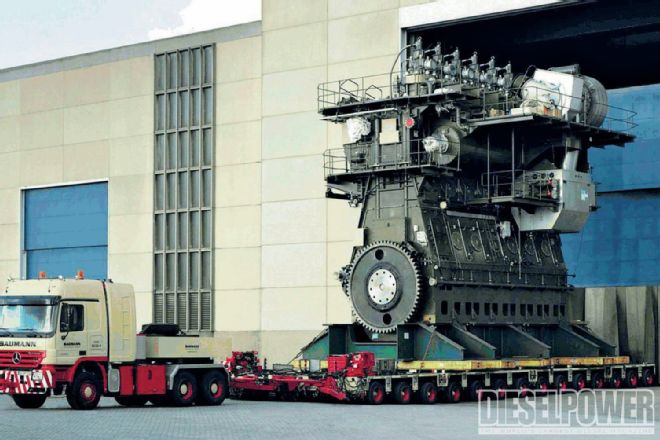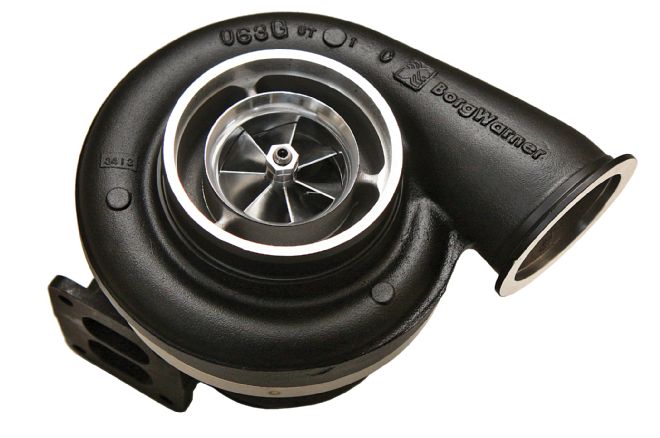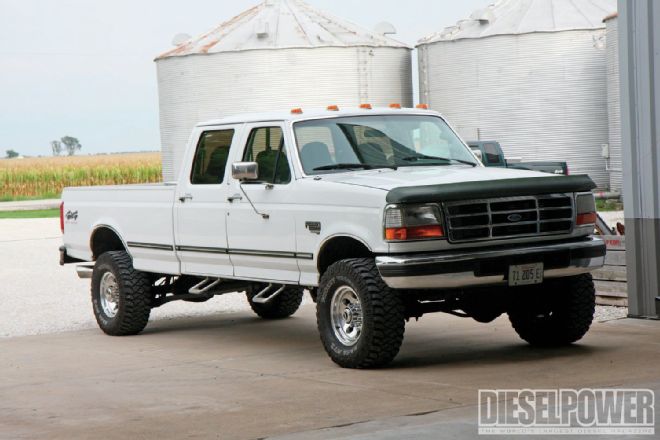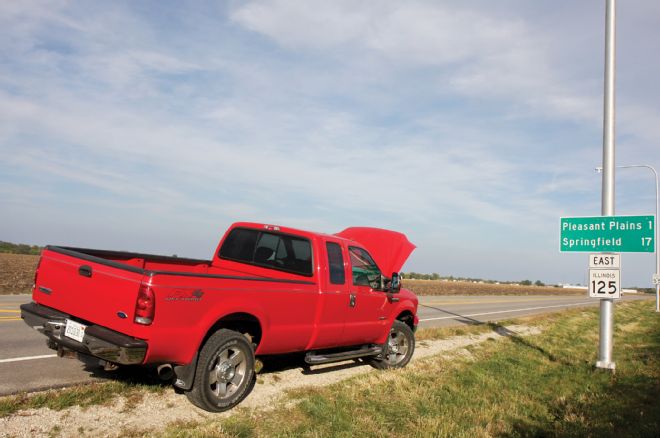Welcome to Top Tech Questions. Oftentimes, readers contact us with questions about articles, or to praise us on what a good job we are doing. But our favorite form of reader communication is tech questions. Our Top Tech section is a place where you ask what's on your mind, and we answer it. Got a trouble code? Wondering how to get your engine to make more power? Send us an email at mike.mcglothlin@sorc.com and we'll do our best to answer it.
How Does It Start?
Question: In the May issue of your incredibly interesting magazine is an article on industrial power: the four-story-high engine of a container ship. I have to ask, how do they start these things? If the crankshaft alone weighs 300 tons, I can only imagine what it takes to get that beast going.
Dennis Drexler
St. Louis, Missouri
Answer: The simplified version of how they start the RTA96-C—and other large-displacement diesel engines—is by using compressed air. Air is pumped into the cylinders (one or more), which moves the pistons down away from top dead center (as they would during normal combustion), which begins to rotate the crankshaft. As the crankshaft's speed increases, fuel is injected into the cylinder and the engine begins to operate on its own.
Digging a little deeper, the RTA96-C uses an intelligent electronic control system to manage the hydraulic fluid rails that activate the exhaust valve, fuel injection, and air injection. The compressed air is injected into cylinders on the power stroke, after top dead center, ensuring the correct rotation of the engine. Since the engine does not use a camshaft for valve actuation, exhaust valves can be operated independently (allowing the engine to decompress cylinders during starting), much like a four-stroke motorcycle engine. Fuel is then injected normally on the compression stroke once the engine reaches an appropriate rpm.
Simple in theory, complicated in practice…

| Firing up the gigantic RTA96-C (and engines like it) isn’t as simple as turning an ignition switch. Compressed air is employed in one or more cylinders to get the 300-ton crankshaft spinning.
Sacrificing
LB-FT for HP
Question: I love reading about the projects you guys are up to: old trucks built in stages to improve upon the previous modification. I understand you set out with a goal in mind—usually a horsepower number—and you must hit it, but I've been looking at the torque on these builds.
In Part 2, your OBS Ford went from 940 lb-ft at 2,725 rpm to 890 lb-ft at 3,000 rpm when the new, larger turbo was installed. You lost 50 lb-ft to gain 23 hp above 3,000 rpm! I just think there is more value in the area under the torque curve rather than peak hp, or peak anything.
You did the same thing with your 6.0L build. On the cover you say "6.0L Turbo Swap: More Power Less Lag." However, when I read the article, in order to gain 13 hp from 3,000 to 3,200 rpm, your torque went from 842 lb-ft at 2,350 rpm to 812 lb-ft at 2,600 rpm. More power (a 3 percent increase beyond 3,000 rpm, yes), but those figures would lead you to a different conclusion on the "less lag" part.
I'm still reading every page you print, and you've got the best magazine out there!
Pasquale Pilato
Connecticut

| As a general rule of thumb, any time you install a larger fixed-geometry turbo but leave the same injectors and/or tuning in the equation, you will lose some low-end driveability (i.e. spool up, or responsiveness). The trade-off of a larger single turbo is the mid-range and top-end power you gain from sacrificing a little low-rpm torque.
Answer: You're right, we did lose 50 lb-ft in Part 2 of our "Keepin' Up With The Joneses" build (March '14), but there is more in play there than you think. Any time you swap a larger turbocharger onto an engine without changing the fuel equation, low-end torque will suffer. When it comes to fixed-geometry turbos (such as the S400 we swapped to), paying a penalty in the spool up department is par for the course, but it's the price you pay in an all-out performance application. In the case of someone who tows often or uses his or her truck to work day in and day out, this isn't ideal. However, in the case of our '97 F-350—a truck that rarely tows or works anymore—we were more concerned with top-end power. Our end goal was to see how fast we could get the truck through the traps at the dragstrip. This means the engine primarily sees 2,800 rpm to 3,500 rpm going down the track, where horsepower is more important than torque. To be sure, torque still plays a role in propelling a diesel down the dragstrip, but in an all-out racing situation, peak horsepower (i.e. high rpm) is always the name of the game. This is why we preach to our readers to build their trucks around the way they drive them, be it for the dragstrip, pulling track, daily driving, or towing. Granted, diesels can do all of these things fairly well, but if you want your truck to excel in one over the other, careful parts picking is required.
With our 6.0L project (Project Outcast), the cover blurb of "More Power, Less Lag" (Part 6, May '13) was a mistake on our part, as the truck did lose some low-end torque (and responsiveness) by upgrading to a larger turbo. However, with a couple tuning tweaks, the driveability of the truck hardly changed. You'll notice that in Part 7 (July '13), more fuel (by way of installing larger injectors) brought a big torque number back into the equation, with the truck picking up 100 lb-ft at 2,450 rpm and ending up at the 912-lb-ft mark at the rear wheels. Then, in Part 8, we spell out the fact that Project Outcast has been a balancing act between more fuel vs. more air (low-end driveability vs. sacrificing some low-end torque for horsepower), which is always the case once you venture past a simple intake, exhaust, and programmer.

| 1997 Ford F 350
Transmission Hiccup
Question: I have an 2009 Ram 2500 with 40,000 miles on the clock that had a rather unnerving transmission episode the other day, and I'm wondering if you've ever seen or experienced this before. After fueling up, I put the truck in reverse, backed out, and headed off down the road. The first sign of something wrong was that the gear selection display on the dash stayed completely lit up, and upshifts were noticeably firmer. Then, when I went to pull away from the first red light, I noticed the truck seemed to be stuck in a high gear, like Fifth or Sixth. The truck would barely move forward and felt totally bogged down. So I pulled to the side of the road, unplugged the batteries, and the issue cleared up. The truck had no trouble codes and is stock aside from 35-inch tires, an intake, exhaust, and a programmer. Should I be worried, or was this a one-time thing?
Glenn Thompson
Palos Verdes, California
Answer: This certainly sounds like an odd issue, and one that we've never personally encountered before. After reaching out to a handful of trusted sources in the industry, we've come to the conclusion that what you have experienced amounts to nothing more than a programmer hiccup. Working on the assumption that your programmer has the ability to switch tunes on the fly (which most do these days), each time the truck is started a link is established between the ECM and the programmer. In this particular instance, there was a miscommunication while the transmission parameters were being loaded, causing the erratic shift behavior. Unplugging the batteries cleared the ECM's temporary memory, allowing a fresh file to be loaded upon the next start. As a one-time issue we wouldn't be concerned, but if it becomes more common (or problematic), we'd suggest contacting the programmer manufacturer directly for a replacement unit.

| The complex nature of today’s diesels can sometimes leave you stranded. If the programmer you’re running skips a beat (even for a nano-second), one of your truck’s systems could fail. This month’s side-of-the-road fix is a perfect starting point for
tackling a simple electronics issue: disconnect the batteries and then reconnect them.
 | Firing up the gigantic RTA96-C (and engines like it) isn’t as simple as turning an ignition switch. Compressed air is employed in one or more cylinders to get the 300-ton crankshaft spinning.
| Firing up the gigantic RTA96-C (and engines like it) isn’t as simple as turning an ignition switch. Compressed air is employed in one or more cylinders to get the 300-ton crankshaft spinning.
 | As a general rule of thumb, any time you install a larger fixed-geometry turbo but leave the same injectors and/or tuning in the equation, you will lose some low-end driveability (i.e. spool up, or responsiveness). The trade-off of a larger single turbo is the mid-range and top-end power you gain from sacrificing a little low-rpm torque.
Answer: You're right, we did lose 50 lb-ft in Part 2 of our "Keepin' Up With The Joneses" build (March '14), but there is more in play there than you think. Any time you swap a larger turbocharger onto an engine without changing the fuel equation, low-end torque will suffer. When it comes to fixed-geometry turbos (such as the S400 we swapped to), paying a penalty in the spool up department is par for the course, but it's the price you pay in an all-out performance application. In the case of someone who tows often or uses his or her truck to work day in and day out, this isn't ideal. However, in the case of our '97 F-350—a truck that rarely tows or works anymore—we were more concerned with top-end power. Our end goal was to see how fast we could get the truck through the traps at the dragstrip. This means the engine primarily sees 2,800 rpm to 3,500 rpm going down the track, where horsepower is more important than torque. To be sure, torque still plays a role in propelling a diesel down the dragstrip, but in an all-out racing situation, peak horsepower (i.e. high rpm) is always the name of the game. This is why we preach to our readers to build their trucks around the way they drive them, be it for the dragstrip, pulling track, daily driving, or towing. Granted, diesels can do all of these things fairly well, but if you want your truck to excel in one over the other, careful parts picking is required.
With our 6.0L project (Project Outcast), the cover blurb of "More Power, Less Lag" (Part 6, May '13) was a mistake on our part, as the truck did lose some low-end torque (and responsiveness) by upgrading to a larger turbo. However, with a couple tuning tweaks, the driveability of the truck hardly changed. You'll notice that in Part 7 (July '13), more fuel (by way of installing larger injectors) brought a big torque number back into the equation, with the truck picking up 100 lb-ft at 2,450 rpm and ending up at the 912-lb-ft mark at the rear wheels. Then, in Part 8, we spell out the fact that Project Outcast has been a balancing act between more fuel vs. more air (low-end driveability vs. sacrificing some low-end torque for horsepower), which is always the case once you venture past a simple intake, exhaust, and programmer.
| As a general rule of thumb, any time you install a larger fixed-geometry turbo but leave the same injectors and/or tuning in the equation, you will lose some low-end driveability (i.e. spool up, or responsiveness). The trade-off of a larger single turbo is the mid-range and top-end power you gain from sacrificing a little low-rpm torque.
Answer: You're right, we did lose 50 lb-ft in Part 2 of our "Keepin' Up With The Joneses" build (March '14), but there is more in play there than you think. Any time you swap a larger turbocharger onto an engine without changing the fuel equation, low-end torque will suffer. When it comes to fixed-geometry turbos (such as the S400 we swapped to), paying a penalty in the spool up department is par for the course, but it's the price you pay in an all-out performance application. In the case of someone who tows often or uses his or her truck to work day in and day out, this isn't ideal. However, in the case of our '97 F-350—a truck that rarely tows or works anymore—we were more concerned with top-end power. Our end goal was to see how fast we could get the truck through the traps at the dragstrip. This means the engine primarily sees 2,800 rpm to 3,500 rpm going down the track, where horsepower is more important than torque. To be sure, torque still plays a role in propelling a diesel down the dragstrip, but in an all-out racing situation, peak horsepower (i.e. high rpm) is always the name of the game. This is why we preach to our readers to build their trucks around the way they drive them, be it for the dragstrip, pulling track, daily driving, or towing. Granted, diesels can do all of these things fairly well, but if you want your truck to excel in one over the other, careful parts picking is required.
With our 6.0L project (Project Outcast), the cover blurb of "More Power, Less Lag" (Part 6, May '13) was a mistake on our part, as the truck did lose some low-end torque (and responsiveness) by upgrading to a larger turbo. However, with a couple tuning tweaks, the driveability of the truck hardly changed. You'll notice that in Part 7 (July '13), more fuel (by way of installing larger injectors) brought a big torque number back into the equation, with the truck picking up 100 lb-ft at 2,450 rpm and ending up at the 912-lb-ft mark at the rear wheels. Then, in Part 8, we spell out the fact that Project Outcast has been a balancing act between more fuel vs. more air (low-end driveability vs. sacrificing some low-end torque for horsepower), which is always the case once you venture past a simple intake, exhaust, and programmer.
 | 1997 Ford F 350
| 1997 Ford F 350
 | The complex nature of today’s diesels can sometimes leave you stranded. If the programmer you’re running skips a beat (even for a nano-second), one of your truck’s systems could fail. This month’s side-of-the-road fix is a perfect starting point for
tackling a simple electronics issue: disconnect the batteries and then reconnect them.
| The complex nature of today’s diesels can sometimes leave you stranded. If the programmer you’re running skips a beat (even for a nano-second), one of your truck’s systems could fail. This month’s side-of-the-road fix is a perfect starting point for
tackling a simple electronics issue: disconnect the batteries and then reconnect them.